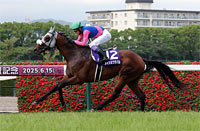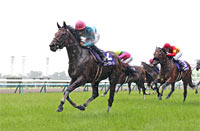Takarazuka Kinen (G1) - Data Analysis
No lack of surprise results in spring season’s top attraction
Last year, Marialite won the Takarazuka Kinen as 8th favorite with win odds of 25.1-1. Looking back over previous years, only two of the 19 winners between 1984 (when the grading system was introduced) and 2002 had win odds of 10 or more – Osaichi George (11.4) in 1990 and Mejiro Palmer (23.1) in 1992. By contrast, seven of the 14 winners between 2003 and 2016 came with win odds of 10 or more. If trends in recent years are anything to go by, we may have to keep a close eye on runners outside the higher favorites as well. Now, let’s analyze features shared by strong performers in this race from results over the last 10 years.
Track record and distance aptitude are important
All 20 Top 2 finishers over the last 10 years had prior experience of winning “JRA 2,000-2,200m G1 or G2” races. Horses in this category also have excellent success ratios, with a Top 2 ratio of 29.4% and a Top 3 ratio of 38.2%. Before all else, we should check whether any of this year’s runners have experience of winning G1 or G2 races over distances close to that of the Takarazuka Kinen. [Table 1]
[Table 1] Performance by experience of winning “JRA 2,000-2,200m G1 or G2” races (last 10 years)
| Experience of winning |
Performance
[1st-2nd-3rd-4th or lower] |
Win ratio |
Top 2 ratio |
Top 3 ratio |
| Yes |
10-10-6-42 |
14.7% |
29.4% |
38.2% |
| No |
0-0-4-79 |
0% |
0% |
4.8% |
Of the above, all four horses finishing 3rd in this race without experience of winning “JRA 2,000-2,200m G1 or G2” races had experienced Top 2 finishes in “JRA G1 races since the previous December.” Runners with a record of vying for the top positions in a JRA G1 race since the end of the previous year could be worth a bet, even if they failed to clear the previous condition. [Table 2]
[Table 2] Top 3 finishers without experience of winning “JRA 2,000-2,200m G1 or G2” races (last 10 years)
| Year |
Finish |
Horse |
Highest finish in JRA G1 races since the
previous December |
| 2007 |
3rd |
Pop Rock |
2nd (2006 Arima Kinen) |
| 2009 |
3rd |
Deep Sky |
2nd (2009 Yasuda Kinen) |
| 2011 |
3rd |
Eishin Flash |
2nd (2011 Tenno Sho (Spring)) |
| 2014 |
3rd |
Verxina |
1st (2014 Victoria Mile) |
Focus on younger horses
Of 30 Top 3 finishers over the last 10 years, 24 were “4-year-olds” or “5-year-olds.” In this race, we should basically focus on the younger runners. [Table 3]
[Table 3] Performance by age (last 10 years)
| Age |
Performance
[1st-2nd-3rd-4th or lower] |
Win ratio |
Top 2 ratio |
Top 3 ratio |
| 3 |
0-0-0-3 |
0% |
0% |
0% |
| 4 |
4-3-6-37 |
8.0% |
14.0% |
26.0% |
| 5 |
4-5-2-31 |
9.5% |
21.4% |
26.2% |
| 6 |
2-2-2-22 |
7.1% |
14.3% |
21.4% |
| 7 and up |
0-0-0-28 |
0% |
0% |
0% |
In the above, all six Top 3 runners aged “6 and up” had experience of winning “JRA 2,000-2,500m G1 or G2” races since the previous August. We should not expect too much of horses aged 6 and up unless they have won a G2 or higher grade race since last August. [Table 4]
[Table 4] Top 3 finishers aged 6 and up (last 10 years)
| Year |
Finish |
Age |
Horse |
Highest finish in JRA
2,000-2500m G1 or G2 since previous August |
| 2007 |
3rd |
6 |
Pop Rock |
1st (2007 Meguro Kinen) |
| 2008 |
1st |
6 |
Eishin Deputy |
1st (2008 Kinko Sho) |
| 3rd |
6 |
Inti Raimi |
1st (2007 Kyoto Daishoten) |
| 2009 |
2nd |
6 |
Sakura Mega Wonder |
1st (2009 Kinko Sho) |
| 2011 |
1st |
6 |
Earnestly |
1st (2010 Sapporo Kinen) |
| 2014 |
2nd |
6 |
Curren Mirotic |
1st (2013 Kinko Sho) |
Look for a strong performance last time out
Of 30 Top 3 finishers over the last 10 years, 23 had finished “In the Top 3” in their previous outing. Those beaten to “4th or lower” have struggled, with a Top 3 ratio of only 9.1%. When comparing the pre-race form, runners with a Top 3 finish last time out should go straight to the top of the pile. [Table 5]
[Table 5] Performance by finish last time out (last 10 years)
| Finish last time out |
Performance
[1st-2nd-3rd-4th or lower] |
Win ratio |
Top 2 ratio |
Top 3 ratio |
| In the Top 3 |
7-8-8-51 |
9.5% |
20.3% |
31.1% |
| 4th or lower |
3-2-2-70 |
3.9% |
6.5% |
9.1% |
No horse finishing “4th or lower” last time out has won this race, except when the previous outing was a “JRA G1” race. Those previously contesting any other race have a Top 3 ratio of only 4.5%. A turnaround from a big defeat in the previous race seems unlikely unless it was a “JRA G1” race. [Table 6]
[Table 6] Performance of horses finishing “4th or lower” last time out, by race condition (last 10 years)
Condition of
previous race |
Performance
[1st-2nd-3rd-4th or lower] |
Win ratio |
Top 2 ratio |
Top 3 ratio |
| JRA G1 |
3-1-1-28 |
9.1% |
12.1% |
15.2% |
| Other races |
0-1-1-42 |
0% |
2.3% |
4.5% |
Poor showing by runners performing well in the Tenno Sho (Spring)
Of 105 total runners over the last 7 years, 15 had finished 4th or higher in that year’s Tenno Sho (Spring), but none of them managed a Top 2 finish in this race. While there was no shortage of Top 2 finishes by horses fitting this bill up to 2009, more recently many runners have been beaten to 3rd or lower even when backed by high favoritism. As such, it might be a mistake to expect too much from runners performing well in the Tenno Sho (Spring). [Table 7]
[Table 7] Performance by experience of finishing 4th or higher in that year’s Tenno Sho (Spring) (last 7 years)
| Experience |
Performance
[1st-2nd-3rd-4th or lower] |
Win ratio |
Top 2 ratio |
Top 3 ratio |
| Yes |
0-0-2-13 |
0% |
0% |
13.3% |
| No |
7-7-5-71 |
7.8% |
15.6% |
21.1% |
Recent success of horses backed by strong favoritism last time out
Of 21 Top 3 finishers over the last 7 years, 15 had been backed “Among the Top 3 favorites” in a domestic race last time out. Conversely, no horse backed as “4th favorite or lower” in its previous outing has won this race; runners in this category have a Top 3 ratio of only 7.1%. If our focus is on trends in recent years, runners backed by strong favoritism last time out should be evaluated more highly. [Table 8]
[Table 8] Performance by favoritism in a domestic race last time out (last 7 years)
| Favoritism last time out |
Performance
[1st-2nd-3rd-4th or lower] |
Win ratio |
Top 2 ratio |
Top 3 ratio |
| Among Top 3 favorites |
7-4-4-36 |
13.7% |
21.6% |
29.4% |
| 4th favorite or lower |
0-1-2-39 |
0% |
2.4% |
7.1% |
Incidentally, the three Top 3 finishers that had been backed as “4th favorite or lower in a domestic race last time out” were all fillies/mares. It might be worth remembering that, since 2010, no “Colts or Geldings” that were backed as 4th favorite or lower in their previous race have finished in the Top 3 here. [Table 9]
[Table 9] Performance by gender of horses backed as “4th favorite or lower” in a domestic race last time out (last 7 years)
| Gender |
Performance
[1st-2nd-3rd-4th or lower] |
Win ratio |
Top 2 ratio |
Top 3 ratio |
| Colts or Geldings |
0-0-0-35 |
0% |
0% |
0% |
| Mares |
0-1-2-4 |
0% |
14.3% |
42.9% |
Seek out the winner!
Avoid overestimating front runners last time out
All of the last 5 winners had been positioned 4th or lower when passing the 4th corner in their previous outing. We should lower our expectations of front runner-type horses that pass the 4th corner in 3rd or higher position. Other features shared by these five are that they all had prior experience of winning “JRA 2,000-2,200m G1 or G2 races since the previous year,” were aged 5 or less, and had been backed among the Top 2 favorites last time out. We should also keep an eye on the trends outlined in Tables 1, 3 and 8. [Table 10]
[Table 10] “Position at 4th corner last time out”, “Highest finish in ‘JRA 2,000-2,200m G1 or G2 races since the previous year’”, “Age” and “Favoritism last time out” of winning horses (last 5 years)
| Year |
Winning horse |
Position at 4th corner last time out |
Highest finish in ‘JRA 2,000-2,200m G1 or G2 races since the previous year’ |
Age |
Favoritism last time out |
| 2012 |
Orfevre |
14th |
1st (2011 Satsuki Sho) |
4 |
1st favorite |
| 2013 |
Gold Ship |
4th |
1st (2012 Satsuki Sho) |
4 |
1st favorite |
| 2014 |
Gold Ship |
14th |
1st (2013 Takarazuka Kinen) |
5 |
2nd favorite |
| 2015 |
Lovely Day |
5th |
1st (2015 Kyoto Kinen) |
5 |
2nd favorite |
| 2016 |
Marialite |
7th |
1st (2015 Queen Elizabeth II Cup) |
5 |
1st favorite |
(Masaya Ibuki))
|




















